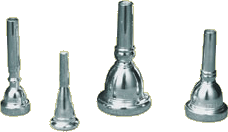Mouthpiece Selection Guide

The mouthpiece has a dramatic effect on the sound produced by an instrument. Even if you cannot afford to buy a new instrument, you can significantly improve your sound by upgrading your mouthpiece. (Saxophone and clarinet players may also want to consider a different ligature when purchasing a new mouthpiece.)
Instruments rented or sold by Ellis Music include a "stock" mouthpiece. These are "middle of the road" mouthpieces, designed to work adequately for a variety of playing situations. Individuals who play casually or infrequently often use these mouthpieces and are satisfied. However, experienced musicians may eventually find themselves held back by the limitations of the mouthpiece. The size of the mouthpiece opening or depth of the mouthpiece cup affect how easily high and low notes are produced and also influence volume and tone quality. For example, a first-chair trumpet player who needs to play frequent high notes will often be better served by a shallower mouthpiece, as this may help with endurance and the ability to make the sound cut through the rest of the band.

Mouthpiece selection is a very personal decision. What works for one person may not work for another. For this reason, it is recommended that you try a variety of mouthpieces before purchasing one. Ellis Music stocks a variety of popular mouthpiece brands, including Selmer, Bach, Yamaha, Vandoren, Otto Link, and Meyer. Please call in advance to check the availability of these mouthpieces if you want to try them at Ellis Music. The store has three "mouthpiece kits" -- for clarinet, saxophone, and trumpet/trombone -- that can be loaned to a music teacher for a period of one week to give his/her students an opportunity to try out mouthpieces at school.
Shop for Mouthpieces
Additional information pertaining to woodwind and brass mouthpieces appears below...
Woodwind Mouthpiece Diagram

Woodwind Mouthpiece Comparison Charts
(Courtesy of American Way Marketing)
Woodwind Mouthpiece Specifications
- Tip Opening (woodwind mouthpieces) - The distance between the tip of the mouthpiece and the tip of the reed. A larger tip opening will generally allow greater volume and flexibility -- such as the ability to bend pitches -- but requires more air and perhaps a softer reed.
- Facing Length (woodwind mouthpieces) - The distance from the tip of the mouthpiece to the point where the reed and mouthpiece meet. A shorter facing in combination with a larger tip opening can lead to greater volume, while a longer facing and smaller tip opening can assist with playing at quieter volumes.
- Chamber (woodwind mouthpieces) - The interior of a woodwind mouthpiece is known as the chamber. The size and shape affects tone quality.
Brass Mouthpiece Diagram

Brass Mouthpiece Comparison Charts
(Courtesy of American Way Marketing)
Brass Mouthpiece Specifications
- Cup Depth (brass mouthpieces) - The distance from the opening of the mouthpiece to the mouthpiece throat. A shallow cup makes high note production easier, while a deep cup improves the tone quality (particularly on low notes).
- Cup Diameter (brass mouthpieces) - The distance as measured from the inner rim on one side of the mouthpiece opening to the inner rim on the other side. A larger cup diameter enables a greater volume of sound and reduces the risk of cracked tones, whereas a smaller cup diameter requires a less developed embouchure but limits the tone.
- Rim Shape (brass mouthpieces) - The rim is the part of the mouthpiece on which the player's lips rest. A wide rim helps increase endurance but limits flexibility, whereas a narrow rim may be helpful to players who must cover a wide range of pitch. The shape of the rim edge -- rounded or sharp -- further affects tone production, with a sharper edge making attacks more reliable.
- Shank Size (brass mouthpieces) - The shank is the long portion of the mouthpiece that fits into the instrument receiver. Many tenor trombones (including student models) require a small shank, while larger bore instruments (including certain tenor trombones with rotors and all bass trombones) require a large shank. Cornets may have a short or a long shank. Unlike the other specifications defined above, which are variable based on player preference, shank size is pre-determined by the instrument (though physical modifications can be made).
Manufacturer-Specific Mouthpiece Resources
Shop for Mouthpieces



